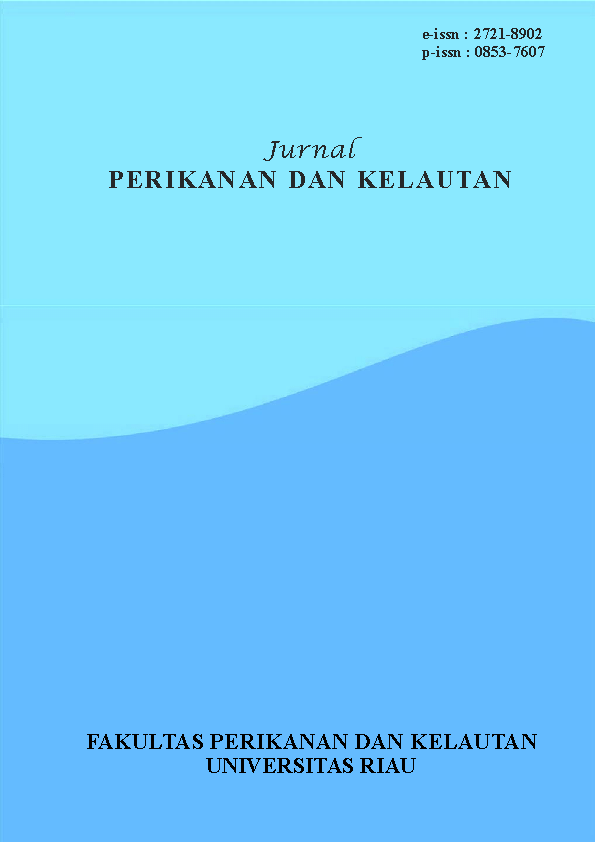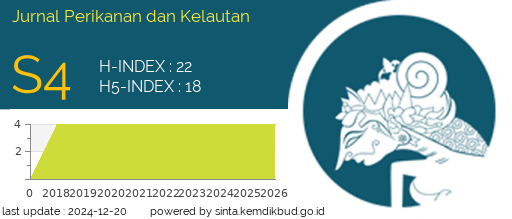Analysis of the Relationship between Organic Material Content and Sediment Grain Size with Macrozoobentos Abundance in Sungai Selari Village, Bengkalis Regency
DOI:
https://doi.org/10.31258/jpk.30.1.13-17Keywords:
Macrozoobentos Abundance, Sediment Grain, Organic MatterAbstract
Sungai Selari Village is an area in Riau Province that features a high density of water activities, including a port where many fishing boats are moored and also serves as a transportation route for fishermen seeking fish. This activity can cause water pollution, which leads to the silting of waters through sedimentation. The activity of sediment input into a body of water can cause changes in the ecosystem, including alterations in sediment texture, organic matter content, and the abundance of macrozoobenthos biota. One organism that can be affected by differences in ecosystems is the macrozoobenthos due to its sedentary nature. This study aims to determine the type of sediment, grain size, and organic matter content, as well as their relationship with macrozoobenthos abundance. This research was conducted in March and April 2023, utilizing purposive sampling techniques at four stations in total. The samples taken were sedimentary substrates and macrozoobenthos. The results indicated that the size of the dominating sediment stalk, specifically the mud fraction, ranged from 14.72% to 71.25%. The types of macrozoobenthos found are grouped into two classes, namely Gastropods and bivalves. Individual abundances range from 0.3 - 4.4 ind/m2, with the highest abundance occurring at station 4 and the lowest occurring at station 1. The organic matter content ranges from 9.27- 34.2%. The relationship between organic matter content and macrozoobenthos abundance exhibits a moderate correlation of 0.506. The relationship between sediment grain size and macrozoobenthos abundance shows a fairly close correlation of 0.544
Downloads
References
Buchanan, J.B. (1971). Sediments, in: Methods for the Study of Marine Benthos, edited by N.A. Holme and A. McIntyre, IBP Handbook no 16. Oxford University Press, Oxford.
Choirudin, I.R., Supardjo, M.N., & Muskananfola, M.R. (2014). Studi Hubungan Kandungan Bahan Organik Sedimen dengan Kelimpahan Makrozoobenthos di Muara Sungai Wedung Kabupaten Demak. Management of Aquatic Resources Journal, 3(3): 168-176.
Hasan, A.A. (2012). Pengaruh Lingkungan Kerja terhadap Kinerja Aktivis pada Lembaga Swadaya Masyarakat di Kota Banda Aceh. Universitas Syiah Kuala
Heiri, O., Lotter, A.F., & Lemcke, G. (2001). Loss of Ignition as a Method for Estimating Organic and Carbonate Content in Sediments: Reproducibility and Comparability of Result. Journal of Paleolimnology, 25: 101-110.
Nurlinda, S., Kasim, M., & Nur, A.I. (2019). Struktur Komunitas Ikan Karang pada Terumbu Karang Buatan di Perairan Desa Tanjung Tiram Kecamatan Moramo Utara Kabupaten Konawe Selatan. Jurnal Manajemen Sumber Daya Perairan, 4(1): 75–82.
Odum, E.P. (1993). Dasar-dasar Ekologi. Tjahjono Samingan, Penerjemah; Yogyakarta: Ed ke-3. Universitas Gadjah Mada. Terjemahan dari: Fundamental of Ecology.
Rifardi, R. (2008). Tekstur Sedimen; Sampling dan Analisis. Unri Press. Pekanbaru.
Downloads
Published
Issue
Section
License
Copyright (c) 2025 Adhita Fiky Fahira, Mubarak Mubarak, Afrizal Tanjung

This work is licensed under a Creative Commons Attribution 4.0 International License.







